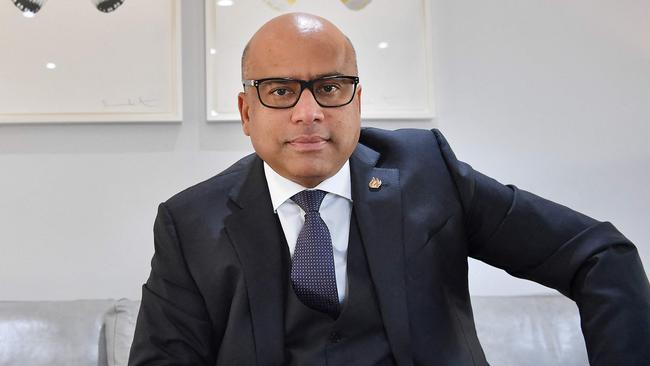Sanjeev Gupta’s Liberty Private Metals is finally unshackled from its debt burden
Liberty Primary Metals Australia’s profit has plunged on lower coal revenues, while the once debt-laden company is now free of third-party liabilities.

Sanjeev Gupta’s Liberty Primary Metals Australia has booked a sharply lower profit for the most recent financial year on lower coal revenues, but says it is now free from third-party debt.
The operator of the Whyalla steelworks and iron ore mines and the Tahmoor coking coal mine made a net profit for the 2023 financial year of $142.3m, down from $434.3m the previous year.
The steel division booked revenue of $1.41bn, up from $1.35bn, and iron ore revenue also increased, from $950.8m to $1.03bn.
However, coal revenue dropped from $846.7m to $598.2m. Total revenue came in at $3.038bn, down 2 per cent.
Capital expenditure was up by 50 per cent to $389m, with the company saying this reflected a focus on investing in the future of the Whyalla operations “where the magnetite expansion is under way’’.
“LPMA’s magnetite expansion project will increase the supply of high quality (70 per cent-plus iron content) ore for lower carbon and green iron production using hydrogen and will feed a new electric arc furnace in Whyalla,’’ the company said.
“During the period LPMA also repaid the remaining amount of $155.5m of the restructured debt, clearing the group of all third-party debt as of 30 June, 2023.’’

LPMA was caught up in the collapse of parent company GFG Alliance’s lender Greensill Capital in March 2021, which left GFG scrambling to refinance almost $6bn globally.
LPMA was on the hook for about $430m refinanced to Credit Suisse Asset Management, with that debt now completely paid off.
The company does still have $202.7m in related party debt, up from $191.4m at the end of the previous financial year.
LPMA said coal mining at Tahmoor had moved from the north to the south deposit, with the planned transition causing a brief reduction in output.
LPMA chief executive Theuns Victor said it was a strong financial result despite “very difficult markets which are driving down the market price and demand for steel products globally’’.
“LPMA’s performance has also enabled us to increase by 50 per cent the amount we invest back into our operations with a focus on our magnetite expansion project which is key to the transformation at Whyalla and our vision to decarbonise steel making,’’ he said.
“With demand for steel expected to increase and commodity prices expected to remain robust, LPMA is well placed to remain in a strong position for FY24 and support the transition to low carbon steel making.”
Mr Victor told the Connecting Green Hydrogen conference in Japan in October that LPMA was advancing talks about co-funding options for the expansion of the steelworks, including with Japanese investors.
The Whyalla steelworks shut down its coke ovens in September, exactly 55 years and 55 days after they completed their first “push” in 1968, as the operation prepares to move to electric steelmaking.
The ambition eventually is to create what the company is calling Greensteel, using hydrogen from the planned hydrogen precinct being developed by the South Australian government on land not far from the steelworks.
Mr Gupta announced in April that a contract had been signed for an electric arc furnace for Whyalla, to replace the coke-fuelled blast furnace.
At the time of that announcement Mr Gupta said it was a $500m commitment, which would reduce carbon emissions from steelmaking by 90 per cent.
The financial report says LPMA intends to have the furnace operational by late 2025.
LPMA also plans to build a new direct reduction plant at Whyalla, which would convert locally-sourced magnetite iron ore to the feedstock needed to supply the new furnace.
That will require new capital, and Mr Gupta has also said LPMA would look at the viability of developing its own hydrogen solutions as well as alternative power sources.





To join the conversation, please log in. Don't have an account? Register
Join the conversation, you are commenting as Logout